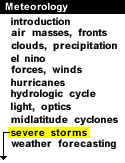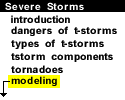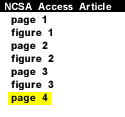
|
 |
||
| "The future of forecasting is local, local, local," says Henry Margusity,
a meteorologist and sales manager for
AccuWeather,
a private weather service that supplies forecasts to some 10,000 clients.
"People want the weather for their backyard."
The potential for eliminating local weather-related surprises is what makes ARPS an exciting endeavor that is attracting the attention of commercial and private enterprises. The South Korean National Government recently adopted ARPS as its official severe storms model. Since 1996 American Airlines has invested more than $1 million, a decision made after two massive hail storms in one week at the Dallas-Ft. Worth Metroplex, American's main hub, cost them millions in damaged airplanes and cancelled or diverted flights. |
||

|
||
| Warren Qualley, who is manager of weather services at American, has
watched the accuracy of ARPS improve over the past two years, consistently
describing the general characteristics of storms. Last summer it predicted
storms that no other model saw. He thinks it is on the verge of making
great strides forward.
"ARPS really turned the corner this past November," says Qualley. "On November 30, it predicted a line of thunderstorms within one-half county and provided a 3-hour lead time to American. It predicted ice on December 23 and fog on January 6 when the other models they consulted either missed these storms or underestimated them. It had other impressive hits, too." ARPS predictions for the Dallas-Ft. Worth airport since December have been on the mark 55 to 60 percent of the time, says Qualley. He and American's 20 other meteorologists hope the reliability of ARPS will continue to improve so that their unit's accuracy rate of 89 percent will climb still higher. Even an increase of a few percentage points can translate into millions of dollars in savings for American. At least for now, ARPS provides information no other models offer. ARPS is also a gamble because it raises people's expectations about what is possible even though the potential for error is great. As Droegemeier likes to point out, a local prediction by ARPS that is off by 20 miles may well be a bust even though that same precision in a prediction on a national map is considered extraordinary. "What Kelvin is trying to do is a high-wire act," says Mohan Ramamurthy, an associate professor of atmospheric sciences at the University of Illinois at Urbana-Champaign. "A lot of meteorologists wouldn't even try to tackle it because even though it is state-of-the-art, the art is in its infancy." It is risky, in other words. Kinda like weather.
|
||






